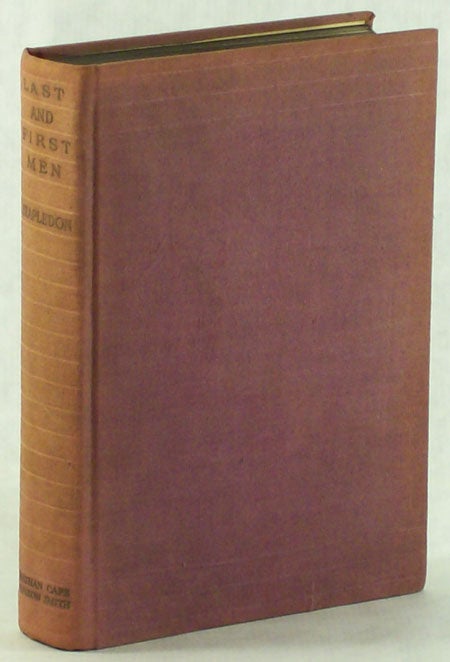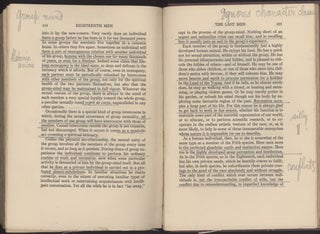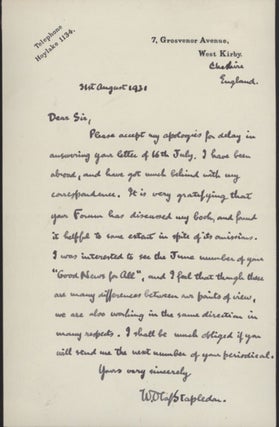LAST AND FIRST MEN: A STORY OF THE NEAR AND FAR FUTURE. New York: Jonathan Cape and Harrison Smith, [1931]. Octavo, pp. [i-iv] v [vi] vii-ix [x] xi [xii] xiii-xvi 1-371 [372: blank], original purple cloth, all panels ruled in blind, spine panel stamped in gold, top edge stained black, fore and bottom edges rough trimmed. First U.S. edition, first binding. "The author's first work of fiction, inaugurating those anatomies of the future that blend romance and philosophy, spectacle and prophecy, cosmological in scope, teleological in tone, for which the term 'novel' is wholly misleading. With its telescopic focus, the Stapledonian romance eschews characters and dialogue, replacing them with Man and Evolution. The half-century to come, as predicted by the author in his foreword, would indeed be critical, coinciding with the high watermark of those social engineering schemes that seemed so congruent with the kind of utopian visions emblazoned here." - Robert Eldridge. "... one of the most remarkable imaginative works in the field of futuristic fiction: an account of human development during the next hundreds of millions of years." - Clarke, Tale of the Future (1978), p. 58. "On his own terms, Stapledon is unequaled, and he certainly has been one of the major influences on contemporary science fiction." - Survey of Science Fiction Literature III, pp. 1140-43. "LAST AND FIRST MEN and STAR MAKER soar far beyond the accepted limits of science fiction ... Stapledon is the great classical example, the cold pitch of perfection as he turns scientific concepts into vast ontological epic prose poems, the ultimate SF writer." - Aldiss, Trillion Year Spree: The History of Science Fiction, p. 198. Stapledon's "influence, both direct and indirect, on the development of many concepts which now permeate genre SF is probably second only to that of H. G. Wells." - Clute and Nicholls (eds), The Encyclopedia of Science Fiction (1993), pp. 1151-53. Aldiss, Trillion Year Spree: The History of Science Fiction, p. 198. Anatomy of Wonder (1976) 3-56; (1981) 2-98; (1987) 2-109; (1995) 2-119; and (2004) II-1069. Bleiler, Science-Fiction: The Early Years 2086. Clareson, Science Fiction in America, 1870s-1930s 718. Clarke, Tale of the Future (1978), p. 58. Clute and Nicholls (eds), The Encyclopedia of Science Fiction (1993), pp. 1151-52. Gerber, Utopian Fantasy (1973), p. 151. Locke, A Spectrum of Fantasy, pp. 204-05. Sargent, British and American Utopian Literature, 1516-1985, p. 190. Stableford, Scientific Romance in Britain 1890-1950, pp. 200-03. Survey of Science Fiction Literature III, pp. 1140-43. In 333. Bleiler (1978), p. 185. Reginald 13553. Satty and Smith A3.2.1. Spine panel sunned, a very good copy. Bookplate of Kenneth Sylvan Guthrie dated 5-12 July 1931 affixed to the front free endpaper and extensive underlining and annotations in Guthrie's hand throughout the text, especially the latter half of the book. Guthrie (1871-1940), American mystic, classical scholar, popularizer of philosophy and occult teachings, publisher, and editor and publisher of GOOD NEWS FOR ALL, a long-running bimonthly inspirational magazine, wrote and self-published A ROMANCE OF TWO CENTURIES: A TALE OF THE YEAR 2025 (1919), a major early twentieth century American utopian novel that presented a very detailed blueprint of the future. An interesting association copy. Accompanied by a signed handwritten 12-line letter (ALs) from Stapledon to "Dear Sir" [i.e. Kenneth Sylvan Guthrie], dated 31 August 1931, answering Gutherie's letter of 16 July. "It is very gratifying that your Forum has discussed my book [LAST AND FIRST MEN], and found it helpful to some extent in spite of its omissions. I was interested to see the June number of your 'Good News for All,' and I feel that though there are many differences between our points of view, we are also working in the same direction in many respects." (#130811).
Price: $1,500.00
'FIRST PUBLISHED IN AMERICA, 1931" on copyright page.




